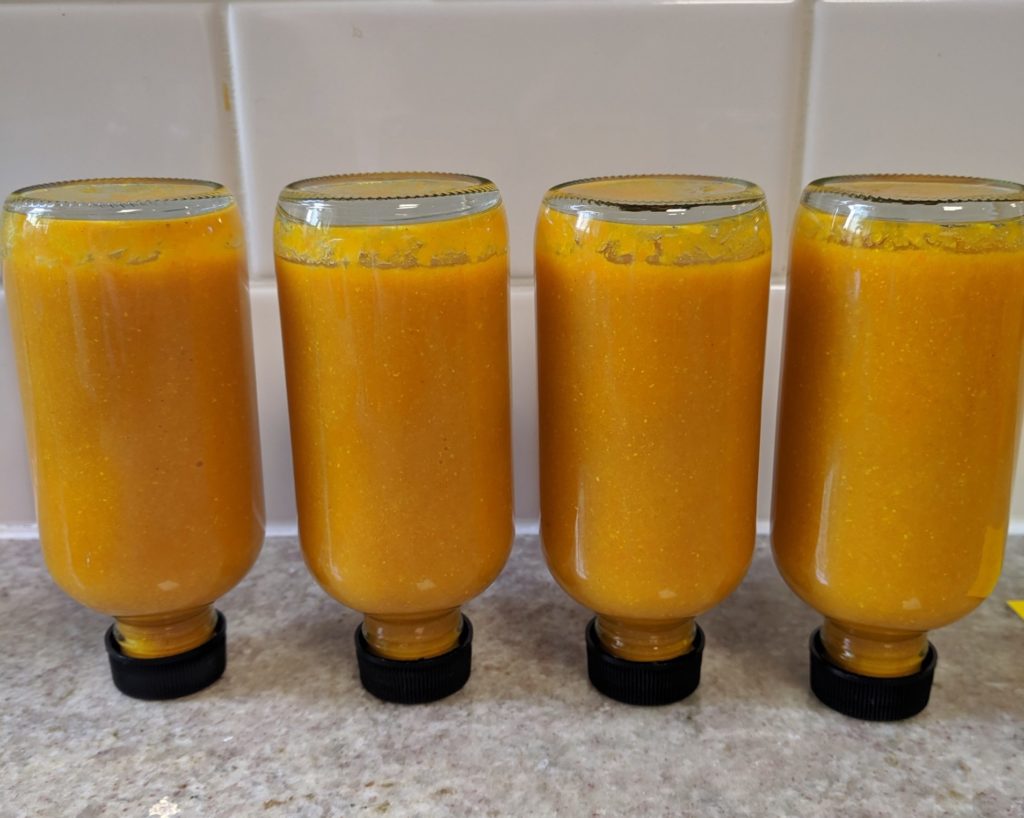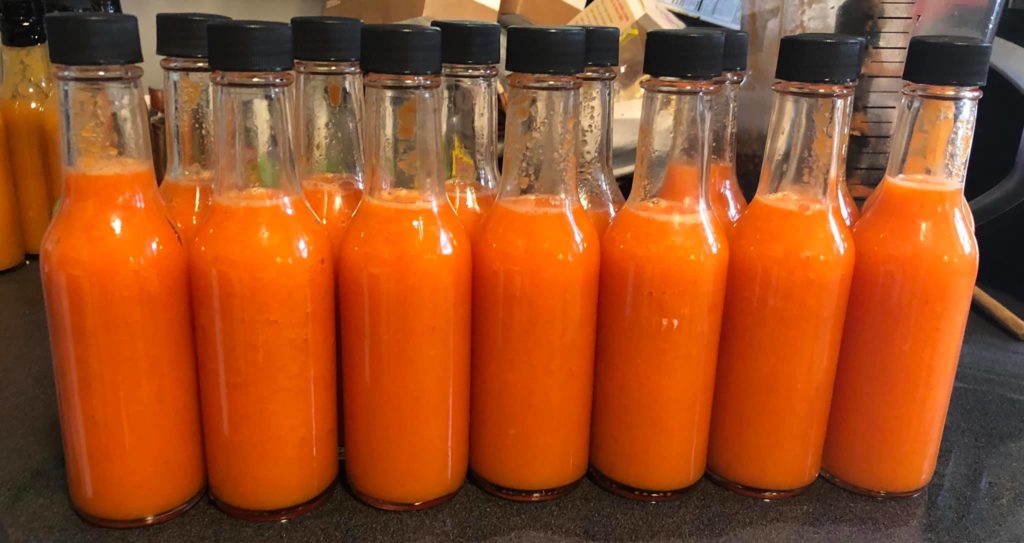You Don’t Have to Ferment to Make Hot Sauce
To be clear, using fermentation to make hot sauce is fine, but we wanted to clear the air.
We were perusing Reddit’s /r/hotsaucerecipes last weekend, as we tend to do, and found someone asking for some beginner help on how to make hot sauce. First of all, awesome, we love seeing these communities band together to help hot sauce newbies and it wasn’t so long ago that we were in a similar position, trying to figure out best ratios, shelf-stability, etc.
Second, we started reading through the most upvoted response and noticed it was around fermenting. That’s all well and good, but when we added a note on a recipe to cook (instead of ferment), OP had no idea you could cook hot sauce!
We’ve noticed this trend around social media and especially in Facebook groups. Stuck in quarantine, many home-dwellers are wanting to make hot sauce and their first instinct, based on what they’ve seen, is to ferment. It’s also possible that a lot of the reason for fermented hot sauce is because there’s an overlap with homebrewers and the processes are pretty similar. Fermenting has its benefits, but it is not the only way to make hot sauce. To explain a bit further, let’s take a look at a couple of the pros and cons (there are obviously more of both).
Pros of Fermenting Hot Sauce
That good good in your gut. Fermented hot sauce is rich in probiotic bacteria and has awesome enzymes for improved digestion.
No cooking required. The spicier the pepper you use, the harder it is to cook in a kitchen. We learned long ago that Carolina Reaper sauces should rarely be cooked in the home. It creates a mace-like effect that will have you and the other dwellers of your residence writhing in pain. Obviously, this is the worst-case scenario, but with fermenting, it’s not a concern at all.
No vinegar needed. By fermenting, you will get the same pH drop that you would typically get from using vinegar right away. Some like it, some don’t. In some cases even after fermenting vinegar is still used to reduce pH further.
Cons of Fermenting Hot Sauce
The amount of time it takes is much higher than cooking hot sauce. Instead of an hour of work gathering, cooking, and blending the ingredients, you have to wait weeks to see how everything blended together in your ferment. Especially when you are starting out, a faster feedback cycle is going to feel more rewarding and likely keep you going for longer. Imagine if you brought us a new hobby and said “alright, I’m ready to try this” and we said “cool, gather these ingredients in a jar and put it someplace dark for a month.” Would you do it? For us at least, we like getting our hands dirty immediately, making mistakes and learning from them in a quicker feedback loop.
Scary bacteria (subjective, we know). Your first time fermenting, you may get scared of how much it’s bubbling or of the kahm yeast that starts growing on top of everything. There are many additional things that can go wrong, but most are avoidable if you’re careful and read up on proper fermentation techniques.
Making Your First Hot Sauce (Without Fermentation)
Think about making your first hot sauce. Do you want to try and learn about percentages, brine, salt intensity, what part of the process to add fruits and other ingredients? Or do you want to slap some peppers in a blender with a few other items and be done with it? It can be super intimidating to think about all the different items you need, the bubbling of your ferment, the possibility of it exploding in your kitchen, and the chance that the ferment turns sour.
The most basic of hot sauce recipes is as follows:
- Grab some peppers, dicing, chopping or none of these, just remove the stem.
- Grab some vinegar
- Grab a lil’ bit of salt
- Combine them all in a blender and get to roughly the right amount of runniness for you (remember some will cook off)
- Throw it into a pan on the stove and cook to a low boil and keep it there for 10 minutes (less if you just want it to keep in the fridge for a couple of weeks)
That’s it. Seriously. It’s super easy, no additional weights, special jars, airlocks, etc. Let it sit in the fridge or on a shelf for a day or two to let the flavors blend together more, but as soon as its done cooking you can use it if you want. For more on the sanitary way to get it into a jar and keep it safe, let’s look at the hot-fill-hold method.

The Hot-Fill-Hold Method of Making Hot Sauce
The short version of explaining the hot-fill-hold method is, put hot liquid into clean container, add cap, invert. The longer version starts with some basic chemistry. When cooking hot sauce, you want the pH to be below 4.1 and the lower it is, the more stable it becomes (we generally target 3.4), and the less likely bad bacteria will grow later on. For quick cooks, refrigeration can help keep things safer, but lower pH lets it hang for even longer.
Once you’ve got everything blended up and ready to put into containers, bring the sauce to a low boil for ten minutes (180-200 degrees F). This satisfies the “hot” portion of this method. While that’s happening, prepare your sterilized containers and then “fill” them. Once filled, secure the cap, invert the container and “hold” it there for a few minutes. Any local department of food safety should have these more official details for guidance as well:
- Fill jars with hot sauce, minimum fill temperature 180°F, target temperature is 200°F, set headspace
at ½” and cover with properly prepared closure/lid. - Invert jar and hold, 180°F or higher for 1 minute or longer. Turn jar ride side up and allow to air cool.
- The hold time is, at a minimum 6 seconds (0.1 minutes) at 178°F. The processor chooses to hold the
product longer, and at a higher temperature, to ensure safety and that a strong seal is achieved on the
container.
It’s fairly straightforward and again, unless you start to make your sauces commercially, all of these are just helpful tips. No one from the FDA is going to randomly show up at your house to test pH if you just want to make a trial sauce and use it up in a few days.
Yeah, But I Still Want to Make Fermented Hot Sauce
Totally cool and who are we to stop you. We know many folks that ferment their hot sauces and the benefits in the bowels are well-documented. Good bacteria, a tangy, sometimes funky-flavored sauce can be a nice departure from cooked sauces. On top of that, this is supposed to be a fun thing for you to do. If fermenting is more fun, go for it, who are we to stop you?
We feel like curmudgeons, but the thing we want folks to know is fermenting is not the only way to make hot sauce. Both methods can make you sick if you’re not careful or using sanitary tools, but both also have their benefits.
Go forth and make it however you want!
If you’re looking for recipes for cooked hot sauce, head on over to our hot sauce recipes page to try some out!
Some Fermenting Resources
In case you’d still like to get rolling with fermenting, here are some resources to learn more. There are many more out there, but these were the ones we found most helpful when we were learning about fermenting. All fermented sauce pictures used were from David Wong, a budding Columbus-based Fermented Hot Sauce maker.
- Serious Eats: How to Make Fermented Hot Sauce
- /r/fermentation
- Fermented Hot Sauce Society on Facebook
- Fiery Ferments (book)
- Friendly Ferments
- Brad Makes Fermented Hot Sauce – Bon Apetit
More From the Fartley Farms Blog
Spiciest Dish in Columbus, OH
Our first ever city series and our quest to find the “spiciest dish” in Columbus, OH
Martha’s Fusion Kitchen – Spiciest Dish in Columbus Series
We’d seen plenty of posts about Martha’s Fusion Kitchen and after a feature in Columbus Monthly, we knew we needed …
Hiro Ramen & Tea – Spiciest Dish in Columbus Series
If you’re new to the robot-served ramen world, you’re not alone.
Is The Spicy Fish Sandwich at Arby’s Spicy?
The spicy chicken world is oversaturated, so it’s time to move to spicy fish sandwiches. If you agree, Arby’s is …
OX-B’s Chicken Joint – Spiciest Dish in Columbus Series
There comes a time in everyone’s life where they want something different. Where they’ve given up on trying the same …
CM Chicken – Spiciest Dish in Columbus Series
Chicken, fried then cooked in a charcoal grill. Need we say more? Several of you have been asking for me …
Carlucci’s Pizzeria – Spiciest Dish in Columbus Series
Sometimes you find a hole in the wall in a plaza that has multiple pizza shops, and sometimes it’s delicious. …
Katalina’s Cafe – Spiciest Dish in Columbus Series
What can we say about Katalina’s other than it’s one of the best spots in the city for breakfast or …
Las Margaritas – Spiciest Dish in Columbus Series
If you put “spicy” and “specialty” in your item name, I’m pretty much a shoe-in for trying it. Such was …
Neehee’s – Spiciest Dish in Columbus Series
We’d passed by the big red N in the sky several times and finally decided to give it a shot. …

